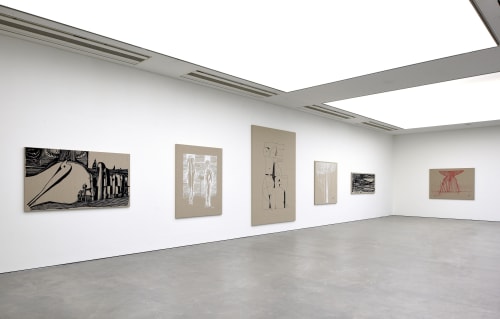Seed Drawings- Pain Relief @ 1:54 Contemporary African Art Fair
Somerset House, Strand, London WC2R 1LA
03 October - 06 October 2019
Silkscreen Paintings – Pain Relief @ Saatchi Gallery, London
Duke of York's HQ, King's Road, London, SW3 4RY
02 October - 06 October 2019
Into the Night: Cabarets and Clubs in Modern Art @ The Barbican Centre, London
Silk St, Barbican, London EC2Y 8DS
04 October 2019 - 19 January 2020
For the first time, Vigo Gallery presents all the Seed drawings from Ibrahim El-Salahi’s Pain Relief series to be shown at the 1.54 Contemporary African Art Fair (03-06 October 2019) at Somerset House. At the same time a selection of the works on canvas will also be on view at the Saatchi Gallery (02-06 October 2019) in Chelsea. El-Salahi’s work also features in Into the Night: Cabarets and Clubs in Modern Art opening at the Barbican from 04 October 2019 - 19 January 2020.
When Ibrahim El-Salahi is drawing he becomes lost in his work and has temporary respite from his sciatica and chronic back pain. For the last two years he has created an extraordinary body of work from the comfort of an armchair, refusing to let physical restriction limit his ambition, making just under 200 tiny, but incredible drawings in pen and ink on the backs of medicine packets, scraps of paper and envelopes.
Despite his physical restrictions, he still wants to communicate in scale, using these drawings as a source or nucleus from which to create large format works on canvas, pressing paint through a scaled up screen-printing gauze onto strong woven linen canvas many times over until a thick inky texture is achieved, amplifying the character of the marks. Limited by his ailments, this method allowed him to achieve what would otherwise would not have been possible.
Throughout his career Ibrahim has returned again and again to the nucleus versus the whole and the organic opening up of an image. When in prison in the 1970s he drew on small scraps of cement casings, which he would join together while the guards were not watching. Thereafter all his black and white works were expansive in nature, whether starting with the nucleus and adding pieces of paper, letting the work grow organically, or in series within notebooks.*
As far back as the 1950s Ibrahim was thinking how to engage people’s attention. Hence his first forays into what became known as the School of Khartoum. Disappointed by the lack of attention from his fellow countrymen and women when he showed his Slade work at the Grand Hotel in Khartoum in the late 1950s, he noted that if he wrote something in Arabic calligraphy on the drawings it attracted interest and people paused to look and read. The words and letters slowly then evolved as he began an exploration of the pictorial qualities and hidden shapes within calligraphic forms. It was a practical means to an end, a way into the work for the audience.
The Pain Relief imagery includes a nod to these early works, with the artist making use of the pictorial possibilities of the braille on the medicine packets.
This body of work, made despite and because of circumstance, serves as a record of memory and contemporary experience fused with ambition to communicate.
Since completion of this project the artist has been inspired, re-entering his new studio built to allow him to make larger work for the first time in over two years. The Ashmolean Museum and Smithsonian Institute have purchased from this important series with several other important museum acquisitions pending,
An article on the series by Maya Jaggi can be seen in todays Weekend Financial Times Collecting supplement and throughout Frieze week at the fairs. Please scroll down to the bottom of the page to view the article.
* In January 2019 The Guggenheim, Abu Dhabi purchased a notebook of 83 drawings completed in the run up to his solo retrospective at Tate Modern in 2013. His Prison Diary, 1976, was also purchased last year by MoMA and has just been co-published in Arabic and English editions with the Sharjah Art Foundation.
For more information, please contact info@vigogallery.com


